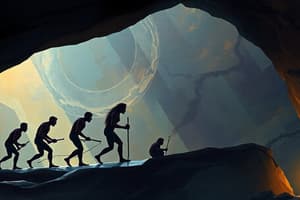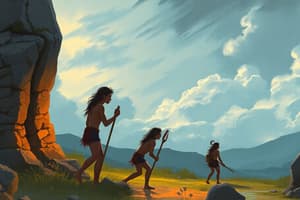Podcast
Questions and Answers
What was the major advantage of Gutenberg's printing press over the previous printing methods?
What was the major advantage of Gutenberg's printing press over the previous printing methods?
- It allowed for faster creation of multiple copies. (correct)
- It exclusively used wood blocks for printing.
- It printed in full color.
- It was operated using steam power.
Which device was developed by Samuel Morse to facilitate long-distance communication?
Which device was developed by Samuel Morse to facilitate long-distance communication?
- The telephone
- The television
- The telegraph (correct)
- The radio
What technology replaced the telegraph in the 21st century?
What technology replaced the telegraph in the 21st century?
- Print media
- Charles Babbage's mechanical computer
- The radio
- The telephone and Internet (correct)
What was significant about the radio when it was first invented?
What was significant about the radio when it was first invented?
What was unique about John Logie Baird's invention of the television?
What was unique about John Logie Baird's invention of the television?
How did the introduction of the Internet impact communication?
How did the introduction of the Internet impact communication?
What is one key function of satellites as described?
What is one key function of satellites as described?
Which of the following is true about the historical development of computers?
Which of the following is true about the historical development of computers?
What role do satellites play in weather forecasting?
What role do satellites play in weather forecasting?
Why did books become cheaper and more available after the invention of the printing press?
Why did books become cheaper and more available after the invention of the printing press?
What was one of the earliest forms of communication used by early humans?
What was one of the earliest forms of communication used by early humans?
What contributed to the development of the first alphabet?
What contributed to the development of the first alphabet?
Where were some of the earliest written records found?
Where were some of the earliest written records found?
How did homing pigeons contribute to communication?
How did homing pigeons contribute to communication?
Which civilization is thought to have established the first postal service?
Which civilization is thought to have established the first postal service?
What was a significant limitation of handwritten books in the past?
What was a significant limitation of handwritten books in the past?
During which period did the invention of writing first appear?
During which period did the invention of writing first appear?
What advancement was key in the modernized postal system during the 19th century?
What advancement was key in the modernized postal system during the 19th century?
Why was the printing press an important invention in communication?
Why was the printing press an important invention in communication?
What function did posting stations serve in the early postal system?
What function did posting stations serve in the early postal system?
Flashcards are hidden until you start studying
Study Notes
Communication Evolution
- Early human communication began with gestures and smoke signals, evolving to cave paintings found in Bhimbetka, Madhya Pradesh.
- Development of symbols for words led to the creation of the first alphabet necessary for trade and record-keeping.
- Earliest writing dates back to the Bronze Age, with clay tablets over 5000 years old discovered in Mesopotamia (modern Iraq).
Pigeon Post
- Around 3000 years ago, homing pigeons were used for delivering messages, tying messages to pigeons' legs.
- Pigeons' natural homing abilities made them effective for long-distance message delivery, especially during battles.
Postal Services
- The first organized postal service is believed to have originated in ancient Persia, enhancing roads and building posting stations.
- The ancient Romans and Indian rulers further developed postal systems, which were modernized in the 19th century.
- Today, postal services facilitate the sending of letters and parcels, with payment typically made through stamps.
Key Inventions in Communication
- Printing Press: Developed by Johannes Gutenberg in the 15th century, it revolutionized book production by using movable metal blocks, making books cheaper and more accessible.
- Telegraph: Invented in the 1830s-1840s by Samuel Morse, it allowed for rapid message sending via electrical signals using Morse Code but has become obsolete with newer technologies.
- Telephone: Introduced by Alexander Graham Bell in 1876, it provided fast communication across the globe; today, mobile phones dominate.
- Radio: Invented by Guglielmo Marconi in the late 19th century, it became a prevalent source of news and entertainment before television.
- Television: First created by John Logie Baird in the early 20th century, it quickly became a major communication tool for both entertainment and education.
Computers and the Internet
- Early computers were large and bulky, but modern computers are compact and versatile.
- The Internet, established in the 20th century, interconnected computers globally, enabling rapid and varied forms of communication, including emails and social media.
- Current uses of the Internet extend beyond communication to include information access, online shopping, and bill payments.
Satellites
- Over 2000 satellites orbit Earth, enhancing global communication by transmitting signals across long distances and overcoming geographical barriers.
- Satellites facilitate live broadcasts and phone calls regardless of location, also aiding in weather forecasting and research through Earth imaging.
Studying That Suits You
Use AI to generate personalized quizzes and flashcards to suit your learning preferences.




